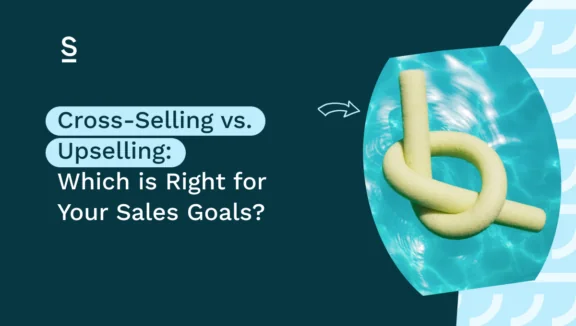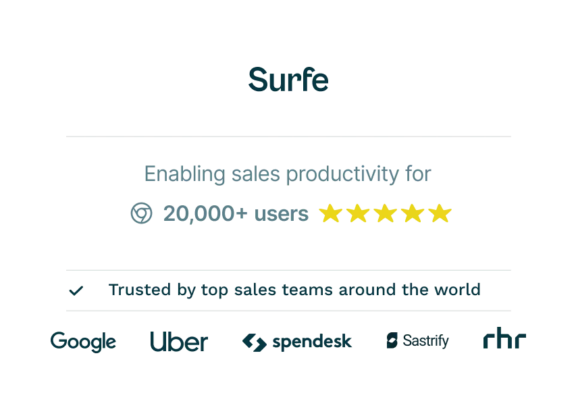Cross-Selling vs. Upselling: Which Strategy is Right for Your Sales Goals?

Ever find yourself getting tongue tied over the difference between cross-selling and upselling? While they might sound like similar tactics in B2B sales, these two approaches play vastly different roles in the sales cycle.
Knowing which is which, who is responsible for each, and when you should dial both up or down in your sales process is crucial to nailing your strategy and converting more high-ticket leads. Ready to learn more and master your cross-selling and upselling techniques? Let’s dive in.
In this article, we’ll cover:
Cross-Selling vs. Upselling: The Key Differences
Cross-selling
Cross-selling is a sales strategy that involves recommending additional products or services that complement the customer’s original purchase. This approach enhances the customer’s experience by providing added value and convenience, while also increasing the overall sales volume.
In B2B sales, for example, if a customer buys a subscription to your webinar platform, you might also suggest purchasing your content writing services to build out a thought leadership series to accompany the webinar content. This would be cross-selling. By effectively implementing cross-selling techniques, businesses can deepen customer relationships, drive higher sales, and improve customer satisfaction through a more personalized buying experience.
Upselling
Upselling is a sales technique where you encourage customers to purchase a more premium or advanced version of the product or service they are considering. This strategy helps enhance the customer experience by offering them better features, functionalities, or added benefits, ultimately increasing the average transaction value.
For instance, if a company is buying a basic software subscription, suggesting an upgrade to a more comprehensive plan with advanced analytics and additional user licenses would be an example of upselling. This approach not only boosts revenue but also ensures that customers receive greater value tailored to their needs.
Why Should I Use Cross-selling and Upselling in B2B Sales?
Now we know what cross-selling and upselling are, let’s dive in to why they can be so useful in generating more revenue and helping your SDRs smash their targets.
Benefits of cross-selling
- Increase Average Order Value (AOV): By recommending additional tools that complement the primary purchase, you naturally elevate the total transaction value. For example, offering software add-ons to a main SaaS subscription can drive substantial incremental revenue.
- Enhanced customer experience: When you suggest products that align with a customer’s initial purchase, it makes their buying journey more comprehensive and satisfying. This not only meets their immediate needs but also anticipates future requirements. Using a search intelligence platform ensures these recommendations are accurate and tailored, creating a seamless shopping experience.
- Build long-term loyalty: Personalized recommendations based on customer behavior and preferences show that you understand their business needs deeply. This personalization fosters trust and loyalty, encouraging repeat business.
Benefits of upselling
- Boost your bottom line: Upselling encourages customers to opt for premium versions of products or services, leading to higher sales revenue. For instance, guiding a client to choose an enterprise-level software package over a basic plan significantly increases profit margins.
- Superior satisfaction for customers: Customers often feel more satisfied when they invest in superior products that offer greater value and functionality. This can result in long-term customer retention and positive word-of-mouth referrals.
- Showcase the depth of your product range: By showcasing a variety of products and your full service suite, upselling highlights the breadth and depth of your offerings. This not only reinforces the quality of your product line but also positions your business as a comprehensive solution provider.
When to Use a Cross-selling or Upselling Strategy
Cross-selling excels in industries like retail, e-commerce, and consumer electronics, where a broad range of complementary products enhances customer experience and increases average order value (AOV). But in a B2B context, it can be tricky to know when to apply cross-selling tactics to your strategy. Imagine a business software purchase; suggesting additional modules or integrations can significantly boost the overall value.
Consider using a cross-sell strategy during times when your customers are reassessing their business challenges like contract renewals, quarterly business reviews, or when new needs emerge. Personalized recommendations that align with the customer’s preferences foster loyalty and demonstrate a deep understanding of their needs.
Meanwhile, upselling cuts through in sectors such as technology, automotive, and travel, where premium options offer substantial benefits. Highlighting the superior features of a higher-end product during the initial sales process or when discussing future scalability can effectively encourage customers to upgrade.
For instance, a basic cloud service user might be persuaded to opt for an advanced plan with enhanced security features. Upselling not only boosts profit margins but also solidifies long-term customer relationships by ensuring they receive the best possible solutions tailored to their growth and challenges. Win-win!
How to Implement Cross-selling and Upselling in B2B Sales
Understand your individual client needs
To successfully implement cross-selling and upselling strategies in B2B sales, it’s crucial to have a deep understanding of your clients’ needs. Start by conducting thorough needs assessments and regular reviews. Armed with this information, you can stay attuned to the evolving requirements of your clients, ensuring that your sales strategies remain relevant and effective.
Additionally, segment your client base to tailor your cross-selling and upselling efforts more precisely. By categorizing clients based on factors like industry, size, and purchasing behavior, you can offer more targeted and appealing solutions.
Offer relevant solutions to client pain points
When it comes to cross-selling and upselling, relevance is key. Ensure that the additional products you’re recommending in cross-selling, as well as the upgraded options in upselling, align closely with the client’s business objectives and challenges.
Use data-driven insights to make personalized recommendations that genuinely enhance the client’s operations and add significant value to their purchase. This not only increases the likelihood of acceptance but also builds trust and strengthens your client relationships.
Timing and placement
We bang on about the importance of timing in sales. But this is especially true when it comes to trying to cross-sell or upsell your customers. The timing and placement of your cross-selling and upselling efforts can greatly influence their success. Cross-selling is often most effective during renewal or upgrade discussions when clients are already evaluating their needs and open to exploring additional solutions.
On the other hand, upselling should be introduced during initial sales discussions or when clients express dissatisfaction with their current solutions. This ensures that clients clearly see the value in upgrading, making them more likely to consider the enhanced options you’re offering. By strategically positioning your sales efforts, you can maximize their impact and drive better outcomes for your business and your clients.
Let’s Wrap It Up!
Cross-selling and upselling are not just buzzwords—they’re strategic powerhouses in the B2B sales arena. Understanding the key differences between these two tactics is essential to effectively incorporating them into your sales process. Cross-selling, by offering complementary products, enhances the customer’s experience and boosts sales volume. Upselling, on the other hand, focuses on encouraging customers to purchase more advanced or premium versions, thus increasing transaction value and ensuring clients receive optimal solutions tailored to their needs.
The real magic happens when you know when and how to deploy these strategies. Cross-selling shines during renewal or upgrade discussions, while upselling is best introduced during initial sales conversations or when clients seek better solutions. By aligning your sales efforts with the specific needs and timing of your clients, you not only drive revenue but also build stronger, more loyal relationships.
Ready to take your B2B sales to the next level? Implementing well-timed, relevant cross-selling and upselling techniques can transform your sales strategy, making your business a trusted partner in your clients’ success stories. Start mastering these tactics today and watch your sales hit new levels and your revenue boom.

Time to make your cross-selling and upselling strategies more effective?
With Surfe’s personalized message templates, you can customize your outreach based on your prospect’s individual pain points.
Frequently Asked Questions (FAQs)
What is the difference between cross-selling and upselling?
Cross-selling involves recommending additional products that complement the initial purchase, while upselling encourages customers to buy a more expensive version or add-on to the product they are considering.
When should I upsell to my prospects?
You should upsell to your prospects during initial sales discussions or when they express dissatisfaction with their current solutions, ensuring they understand the value of upgrading.
How can I improve my cross-selling or upselling techniques?
Improve your techniques by understanding client needs through thorough assessments, offering highly relevant and personalized solutions based on data-driven insights, and strategically timing your recommendations during renewal or upgrade discussions.


